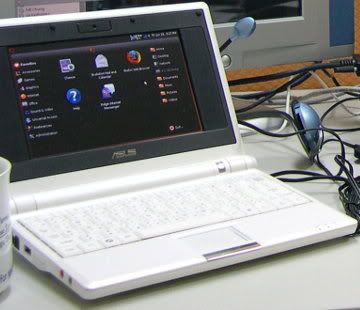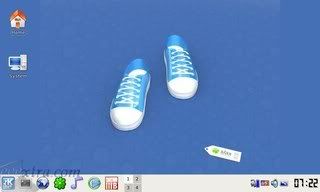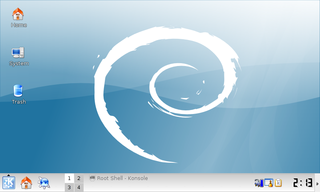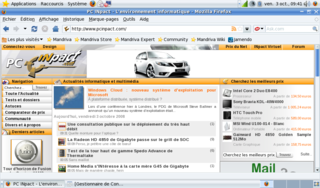Source: Five Best Linux Distributions (excerpts)
In the call for contenders, we asked not only which Linux distribution was your favorite, but a note on why, with the hope that readers new to Linux would learn a thing or two. You responded in force. This was the most popular Hive Five to date, with over 800 votes and many helpful comments.
Which Linux Distribution is Best? (Poll Closed)
64% Ubuntu/Debian/Linux Mint (10901 votes)
9% Fedora (1557 votes)
8% Gentoo (1290 votes)
7% Arch Linux (1245 votes)
7% openSUSE (1230 votes)
5% Other (816 votes)
openSUSE
 While not quite as simple to install as some of the other distributions on the list, openSUSE is quite user friendly. This distribution includes YaST (Yet another Setup Tool) to make installing applications a breeze. The user interface also gets a boost from Slab, a polished Windows Vista-like start menu. openSUSE puts an emphasis on hardware support and ease of use, making typically troublesome tasks like setting up a multi-monitor system less awkward. OpenSUSE is also part of the SMOLT driver project—when you install it, you can opt in to participate in a hardware survey to help continue the growth of Linux and foster support for new hardware.
While not quite as simple to install as some of the other distributions on the list, openSUSE is quite user friendly. This distribution includes YaST (Yet another Setup Tool) to make installing applications a breeze. The user interface also gets a boost from Slab, a polished Windows Vista-like start menu. openSUSE puts an emphasis on hardware support and ease of use, making typically troublesome tasks like setting up a multi-monitor system less awkward. OpenSUSE is also part of the SMOLT driver project—when you install it, you can opt in to participate in a hardware survey to help continue the growth of Linux and foster support for new hardware.Ubuntu / Debian / Linux Mint
 Purists might complain that we've opted to group Ubuntu, Debian, and Linux Mint together, but compared to the other top nominees, they have more in common than not. Ubuntu is based on Debian, and Linux Mint in turn on Ubuntu. That said, they have distinctive appeals. Ubuntu currently has the largest share of the Linux user base, thanks in large part to a user-friendly installation, a desktop designed to accomodate first-timers, and a rigorous new released schedule. Ubuntu also comes bundled with an extensive set of open-source software to cover the needs of first-time switchers, but also includes only truly free software in its default installation, winning fans on both sides of the open-source aisle. Debian may not come pre-packed with as many applications, but users can easily retrieve over 25,000 applications from Debian, third-party repositories, and sites like GetDeb.net. Linux Mint shares much of its lineage with Ubuntu, but aims for a clean, green-themed, mostly new look. The distribution has a strong focus on immediate functionality, with a largers driver set included at first installation. It also includes Mint Tools, a set of configuration apps and wizards that strive to make configuring and managing Linux as painless as possible.
Purists might complain that we've opted to group Ubuntu, Debian, and Linux Mint together, but compared to the other top nominees, they have more in common than not. Ubuntu is based on Debian, and Linux Mint in turn on Ubuntu. That said, they have distinctive appeals. Ubuntu currently has the largest share of the Linux user base, thanks in large part to a user-friendly installation, a desktop designed to accomodate first-timers, and a rigorous new released schedule. Ubuntu also comes bundled with an extensive set of open-source software to cover the needs of first-time switchers, but also includes only truly free software in its default installation, winning fans on both sides of the open-source aisle. Debian may not come pre-packed with as many applications, but users can easily retrieve over 25,000 applications from Debian, third-party repositories, and sites like GetDeb.net. Linux Mint shares much of its lineage with Ubuntu, but aims for a clean, green-themed, mostly new look. The distribution has a strong focus on immediate functionality, with a largers driver set included at first installation. It also includes Mint Tools, a set of configuration apps and wizards that strive to make configuring and managing Linux as painless as possible.Fedora
 If you're looking for an influential endorsement for a Linux distribution, you won't find one much better than being the distribution of choice for Linus Torvalds, the father of Linux. Fedora came into being in 2003 as a spin-off of Red Hat Linux's free personal distribution, when the latter was discontinued. Although technically a younger distribution, it's a seasoned and solid Linux release with a strong corporate backing and user following. Fedora comes in a variety of "spins," tailored with different apps and functionality, so you can get more of what you want without having to hunt it all down.
If you're looking for an influential endorsement for a Linux distribution, you won't find one much better than being the distribution of choice for Linus Torvalds, the father of Linux. Fedora came into being in 2003 as a spin-off of Red Hat Linux's free personal distribution, when the latter was discontinued. Although technically a younger distribution, it's a seasoned and solid Linux release with a strong corporate backing and user following. Fedora comes in a variety of "spins," tailored with different apps and functionality, so you can get more of what you want without having to hunt it all down.Arch Linux
 Arch Linux is a lightweight Linux distribution which strives to "Keep It Simple". It's definitely not a Linux distribution for novices, as it installs with just a bash command prompt and no GUI desktop—the screenshot here shows Arch Linux with a basic KDE desktop installed. You get a pretty lean, spartan system at first, but it can be quickly built onto using the Pacman package manager. There's an extensive list comparing Arch to other distributions in the distro's wiki, and it's definitely worth a look if you're trying to decide whether Arch is for you.
Arch Linux is a lightweight Linux distribution which strives to "Keep It Simple". It's definitely not a Linux distribution for novices, as it installs with just a bash command prompt and no GUI desktop—the screenshot here shows Arch Linux with a basic KDE desktop installed. You get a pretty lean, spartan system at first, but it can be quickly built onto using the Pacman package manager. There's an extensive list comparing Arch to other distributions in the distro's wiki, and it's definitely worth a look if you're trying to decide whether Arch is for you.Gentoo
 Gentoo Linux starts you off with even less than Arch, as you essentially build your system from scratch during the initial install. Sure, you can download a totally pre-packed version and even a live CD, but the traditional way to install Gentoo is to compile a unique configuration specific to your hardware and software needs right from the start. There are tons of choices and options during installation, but they're pretty clearly explained. Some readers noted that, although they started with other distributions of Linux, it wasn't until they started using Gentoo that they really got their hands dirty and learned how Linux really runs.
Gentoo Linux starts you off with even less than Arch, as you essentially build your system from scratch during the initial install. Sure, you can download a totally pre-packed version and even a live CD, but the traditional way to install Gentoo is to compile a unique configuration specific to your hardware and software needs right from the start. There are tons of choices and options during installation, but they're pretty clearly explained. Some readers noted that, although they started with other distributions of Linux, it wasn't until they started using Gentoo that they really got their hands dirty and learned how Linux really runs.Source: 8 Rocking Linux Distros
March 30, 2009 at 01:40:00 PM, by Blair MathisDefining the best Linux distros is like defining the best car--one does not exist; instead, the best cars are the ones that meet your needs, and your needs may vary wildly from the needs of another person.
The eight distros below are listed based on several different criteria--community, usability support, etc.
This article avoids, for lack of a better word, "general" distros--for example, Debian isn't on the list because Ubuntu is; overall, Ubuntu is the better option for most users over Debian. This list covers several different types of distros: full desktop, LiveCD, and lightweight, etc.
Ubuntu
Let's say you're completely new to Linux, and you're looking for a place to start. You're the exact image of an everyday user--email, homework, Internet, music, slight photo editing--and you just want a distro that is easy, that you don't have to invest much time in learning, that works well, and that many other people use. If that sounds like you, then Ubuntu is the place to look.
Ubuntu is a full desktop operating system that is robust and regularly updated, and is based on Debian. It is easy for everyday users to use--there is a small learning curve and a large community. Most Linux tutorials found online are based on Ubuntu, which is another reason users new to Linux should give Ubuntu a serious look.
Installing Ubuntu is a simple task anyone can do, the most complicated task being choosing how much of the hard drive to give the install--and that only requires a check box and slider, so you can image how simple the rest is.
Software is free and open source, and can be downloaded via Add/Remove Applications, where you'll find almost every type of software you could want, all the way down to Japanese dictionaries and astronomy tools.
Ubuntu uses Gnome by default, but for those who prefer KDE, there's Kubuntu; Xubuntu uses XFCE for slower systems; Edubuntu is a version specifically for education; there's even Eeebuntu for Eee PC netbooks.
Sabayon
Sabayon is to Gentoo what Ubuntu is to Debian--it's a Gentoo fork, and a very good one at that. If you're having issues with Ubuntu, you have past experience with Gentoo, or you'd rather get your feet wet with Gentoo then Debian, give Sabayon a shot.There are two versions of Sabayon--the full desktop version, and a mini version, which is ideal for older computer, low-capacity netbooks, or just to reduce the size of you install.
Sabayon is released as a LiveCD and can be easily installed from that. During installation, you can choose to install the default KDE interface, or instead add Gnome or XFCE. The rest of the installation is identical to Ubuntu, and involves selecting simple settings.
Desktop effects are activated by default in Sabayon, and coupling that with the default KDE guarantees more eye-candy than you can imagine. Installing software is now simple due to the Entropy package manager. You can scroll through the available software and check the box next to it to install the software.
Knoppix
One of the great things about Linux is just how versatile it can be. The above two distros are both full desktop distributions that are meant to completely replace Windows or Mac and do everything you could need. Knoppix, while a robust distro in it's own right, is different in that it was designed to be used as a LiveCD--run and used directly from the optical drive. Taking that a step further, this distro can be installed and run directly from a USB thumb drive; aside from that, Knoppix can be installed to the hard drive, but isn't the most comfortable to run that way.
Knoppix defaults with the KDE interface and is a relatively small distro. It, like Ubuntu, is based on Debian. It is ideal for those who want to access a computer with an inaccessible operating system, for backing up files off a hard drive with a corrupted OS, or for simply running a lightweight system on an old computer. One of the best features is it's ability to find and connect to just about any network.
It comes default with 1000 software packages and runs the LXDE, a lightweight and fast interface. If you want to use the operating system consistently, you can create a persistent home directory, which allows you to save your data for later access. In addition, you can save your data over the network on a different computer or onto a flash drive/hard drive.
Crunchbang
Crunchbang is touted as the lightweight Ubuntu. It is based off Ubuntu 8.10, but it is light and fast. It uses OpenBox instead of Gnome, and comes as an installable LiveCD just as Ubuntu does. If you're familiar with Ubuntu, then you're already have a good grasp on Crunchbang. The biggest difference over it's big brother, aside from the fast interface, is the automatic inclusion of proprietary devices, such as Adobe Flash, DVD support, video codecs (AVI, etc), and music codecs. In addition, it swaps out OOo for Abiword, a nature swap given it's lightweight nature.
This distro is ideal for those who enjoy Ubuntu, but don't want the bloat; also, it is the best option for those who want Ubuntu, but don't have the hardware to support the distro.
Puppy Linux
Puppy Linux is a completely independent distro and is actively updated and changed, and has a large user base--it is a LiveCD distro and is, like Knoppix, intended to run as a LiveCD or from a USB thumb drive. The difference comes in the fact that Puppy Linux is loaded into the RAM, allowing the physical disc to the be removed, whether a CD or USB drive.
It comes with a suite of apps that allow you to do all the basics: chat, Internet, email, photo editing, VoIP, etc. It is available in different 'puplets' which are versions of Puppy Linux that offer different feels/interfaces. A good example is Vesta Puppy, which is a joy to use.
PClinuxOS
This distro has worked it's way into the heart of many a Linux user, and is a popular option. It is based on Mandriva. It comes default with KDE and is available as a Gnome version. Software installation is simple with the Synaptic Package Manager via it's own software repository. A big feature of this distro is that it's easy to remake as your own via mklivecd.
Because of the mklivecd feature, there are many remastered and distributed versions of PCLiS, including lightweight options, different languages, versions specifically for businesses, etc.
If you want a desktop system that runs fast and has a versatility to make your own version, PClinuxOS is the distro for you.
Damn Small Linux
Damn Small Linux is only 50MB--you can't get smaller than this. The lightest, fastest Linux distro you can find, DSL is so small, you can easily keep it on your USB thumb drive as a tool when situations get sticky, for use on computer's that are not your own, and on systems that are so old, you couldn't run anything else. It can run completely within RAM (at least 128MB), making your computer as fast as possible.
This OS will expand dynamically as you add apps. It comes default with music and video player, an FTP client, web browsing chat, spellcheck, pdf viewer, PCMCIA and USB support games, ghost printer, and more. You can add items as you see fit, and save your data to a persistent directory or onto the extra space on a USB drive.
In addition, DSL can be run from directly within Windows, making it even more versatile.
Linux XP Desktop 2008
Lets say you're looking to switch from Windows to Linux, but the thought of a different interface terrifies you. Linux XP Desktop 2008 is probably the ideal distro for you, in that it was designed to specifically look like Windows Vista; if you're partial to the XP interface, look at Linux XP. Unfortunately, there isn't a lot of info about the Linux distro, perhaps as a way to keep the distro as non-frightening as possible.
It appears to be based off Debian, though that is not confirmed. It uses WINE as a way to allow you to run many different Windows apps. Overall, if you're trying to escape from the Windows-sphere, I recommend jumping into a 'normal' distro, such as Ubuntu or Sabayon. If, however, you're adamant about having as familiar of an interface as possible, Linux XP can be a good stepping stone.
The unfortunate part of this is that it is shareware--after 30 days, you have to buy a license, which many feels goes against everything Linux stands for.

Update:Top 5 Netbook Linux Distros: 2010 Edition
Hi there! Have you already jumped onto the netbook bandwagon? I currently own a MEDION PC, a MacBook and a Nokia E71, but my inner-geek still craves for a cool little Linux netbook. Sub-notebooks are great stuff: they are, like Linus Torvalds said in a recent interview, “laptops done right”. You can carry them around, they are light, small and cheap so you do not have to worry as much if you lose, or break them. At the same time though, you can do some serious work with thee mini laptops.
Linux is for now, alongside Mac OS X (a warning though, installing the latter is supposed to be illegal) one of the best operating system choices for a netbook.
Windows 7 does have a smaller memory print in comparison to Vista, but many sub-notebooks are still too weak to run anything more by Microsoft than XP, which you will probably have to settle for if you are not thinking of installing Linux.
Some of the advantages of running Linux on a sub-notebook are a smaller memory footprint, better security and tons of free applications right out of the box.
If you decide to install it by yourself, you may encounter some compatibility problems here and there, therefore it is wiser to buy one of the more widely-sold netbooks such as the Eee PC or the Acer Aspire One.
Although, with a little tweaking, you should have better chances at installing Linux than Windows. So here are some Linux distributions I recommend you try out, because they are modified to work well with small screens and modest hardware.
Disclaimer: I have not tested all of these Linux distributions and I am not guaranteeing they will work, let alone install – these are simply my suggestions based on people’s reports and opinions and my own messing around with the Eee PC and, briefly, the MSI Wind. I am not going to talk a lot about the software included, if you’re interested in knowing more about the recommended distros, please visit their respective sites.

Sporting a very interesting windowing interface, Ubuntu Netbook Remix is Canonical’s bold foray into the netbook business. They have done a great job at tailoring their flagship distribution for mini laptops. I’m only worried that GNOME and Ubuntu as a whole may not be light enough for every sub-notebook. Nevertheless, all the stuff you’d expect in Ubuntu is there, so if you find it to work well with your system, this is probably the fastest way to get you up and running with a stable and feature-rich operating system.

Ubuntu’s elegant little brother, a spin-off of the Crunchbang distro, does away with GNOME. There is only a window manager, namely Openbox and a sleek black background with a neat Conky setup. A lot of fat has also been trimmed in the application department, if you want Openoffice you will have to download it yourself. By default you get Firefox, VLC, Skype, Flash and a lot of other useful programs for your everyday computing needs. I understand the decision of not including Openoffice, it is a big app and I myself use only the most basic functions of a word processor, the only problem are compatibility issues with documents you get from other people. Always a big pain. Give Cruncheee a try. It is much lighter than UNR.

Slax, a KDE3-based distribution built on top of Slackware Linux, is primarily meant for use as a Live distribution. It seems to have become fairly popular among netbook owners, and I was pleasantly surprised because I like SLAX very much. You can customize your ISO image from the website for your needs, to get a simple, fast, stable and user-friendly distribution, perfect for running off a thumb-drive or Flash memory, which is always a big plus for netbooks since they normally have less storage space than normal PC’s. By the way, version 6.0.9 is supposed to have fixed some previous netbook issues, so one more point for SLAX there 

If you read my blog often, you will know I am a strong supporter of Debian. And I have good reasons: the sheer number of packages, users and documentation is overwhelming. Debian is extremely compatible and easy to install, works on many different architectures and is mostly rock-solid. Sometimes Debian will simply work where most distros fail. That is why you may want to install Debian on your netbook:
- you can find all the necessary documentation
- more than 20,000 packages waiting for you in the repositories
- tested for stability and reliability

As much as I am paranoid about distros that use the RPM format or an enhancement of it, I’ll admit RPM has evolved a lot and is now very mature so no need to worry about dependency hell any more than on DEB-based distros. Even though Mandriva has prepared a special, currently unavailable netbook respin, the standard free version of Mandriva should now have full support for the most popular netbooks, such as the Eee. We’ve been discussing Mandriva in July on the Linux Void podcast and my co-host Peter was pleasantly surprised. As you may know already, Mandriva is a uRPMi-based French distribution that competes with Fedora, Ubuntu, OpenSuse and other desktop and new-user-oriented Linux distros. Mandriva prefers the KDE4 desktop, but it also features other desktop environments (GNOME and Xfce).
Runners-up:
Arch Linux – I love Arch. Many Arch users on the Arch BBS use their favorite distros on their netbooks, too. Takes some time to setup, though.
Puppy and Pupeee – Puppeee and Puppy are extremely light.
Puppy gives you root permissions all the time so I do not really recommend it that often, even if it is a great little distribution. This one also tends to work on some exotic hardware.
What about you? What do you run on your netbook?







 LibreOffice
LibreOffice Firefox
Firefox
No comments:
Post a Comment